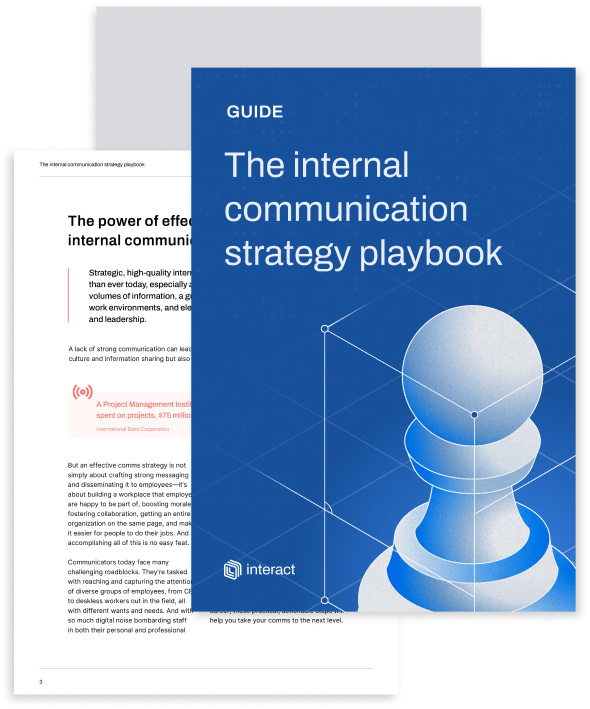Even if you’re a seasoned comms pro, creating an annual internal communications plan can feel overwhelming when you’re staring at a blank document and every project changes daily. Whether you’ve never created an IC plan or you’ve got a mountain of them under your belt, here are four things to remember in a strategic internal communication plan.
Is it worth making an internal communication plan?
Short answer…yes.
Change is the water that internal communications professionals swim in. From launching new software platforms to announcing strategic shifts, a career in comms requires the agility and resilience needed for an often reactive environment.
When you factor in the tide of global geopolitical conflicts and economic shifts that have characterized the last few years, you’ve got even more change to cope with. So, it might be easy to throw up your hands and say why even bother creating a content plan for internal comms. It’s worth it because there are always large strategic goals and themes that we need to touch.
While employee experience, sustainability, and hybrid working have all moved from the periphery to the center, other strands also remain essential. Employee engagement, DE&I, and culture: these are all things that have taken on even more importance and require a continued annual focus in your internal communications plan.
As you go about building an internal comms plan, here are four things you need to remember.
1: Evaluate last year’s internal communications plan
Before we move forward, we need to look at where we’ve been. If we don’t understand what has worked previously – or where our weaknesses and gaps are – we’re doomed to repeat the same mistakes or become static.
So, evaluate.
Look at any internal communications campaigns you ran in the previous year and audit the results. This will give a sense of whether the content was popular enough to be worth resurrecting again, and whether the formats and channels you used had particular strengths or weaknesses.
If you ran a campaign about employee benefits that had high engagement from office employees but not those in retail stores or warehouses, perhaps the lack of desk-less support was not due to the content but to the lack of mobile and digital signage internal communication.
Some questions to ask include:
- Why were these campaigns undertaken?
- Which times of year were your busiest or least busy?
- Did you collaborate with and represent every department in the organization?
- Which comms channels did you use in your campaigns?
- What were the results and how were they measured?
- Was there any anecdotal feedback from colleagues or senior leaders?
Don’t just consider campaigns in isolation, however.
Look to the overall contribution your communications efforts made to the business, and how that aligned with business objectives. How did you define success? Did you realize your goals?
Finally, seek feedback from your audiences. Use surveys to request anecdotal feedback. It may also help to look at your competitors, and what they’re doing. Use social listening techniques through Glassdoor or LinkedIn to observe the general feeling about company comms in other workplaces. Is there something a competitor’s employees mention they love?
Building a research-based picture of what works – and what doesn’t – will help steer the plan for next year’s internal comms strategy.
Summary
- What themes did you explore in the previous year?
- How were campaigns delivered?
- What were the results/measurements of success?
- How did comms contribute to overall business objectives?
- Seek feedback from your target audience
- Look at competitors
2: Setting internal comms goals
You know where you are now. So, where are you headed – or where do you want to be?
Communication has evolved from a tactical tool to distribute necessary information to a key element of business strategy. Take time to look at the overall business objectives and direction of the organization for the year ahead and then determine the role communications should play in supporting those.
14 steps to great internal communications
industry changes, regulatory updates, or the wider economic and political landscape. Having a sense of what’s coming may help to set some key goals and campaigns for your IC plan.
Seek input from multiple departments on what their goals are too. They may have specific objectives that require comms support over the coming 12 months.
Revisit or define your key messages – whether for the organization, particular campaigns, or specific parts of the company.
- Who are you and what do you stand for?
- What is your mission and your brand?
- What is important to the workforce and what is that ‘certain something’ that makes it unique?
Finally, take time to re-evaluate what is perceived to be “effective” or “successful” communication. Is your campaign a success simply because people look at what you’ve distributed or are you seeking action?
If it’s relevant, determine key performance indicators (KPIs) and set tangible, quantifiable goals. “Increase employee engagement” is not an objective. “Increase employee traffic to the company intranet news pages by 5% by the close of Q2” is.
Make the objectives in your internal communications plan Specific, Measurable, Achievable, Realistic, and Time-bound (SMART).
Summary
- Align with business objectives
- Identify 2023 events, changes, or challenges
- Go company-wide
- Define your key messages, brand, and tone of voice
- Determine what ‘success’ looks like
- Set out quantifiable KPIs
3: Define the tactics in your internal comms plan
Now you have some idea of where you want to go, it’s time to figure out the route there. This part of your plan is the “brass tacks:” the tactical specifics.
Start with your audience. Who are you targeting and has that changed? Don’t assume that this remains the same; consumer trends change regularly, and the presence of Generation Z in the workplace has strong implications for internal comms.
How do you segment and target your audiences? As consumers, we expect personalized messages from brands, so employee personalization and tailoring of communication are more vital than ever.
Consider introducing employee personas into your internal communications plan if you haven’t already. These use behavioral, demographic, and psychographic research and data to form a fictitious archetypical character that can be utilized to shape your messaging.
Next, look at your communication channels and content. What are you currently using that has proven successful? Are there alternatives you may want to introduce to your plan, or certain channels that should be given higher priority?
The continuing trend towards visual communication may see you shift towards more interactive or video content, for example. In terms of channels, are frontline workers without email access seeing your content on employee mobile apps or digital signage?
Create an internal communications calendar of key events or areas of focus for each month or quarter. How far in advance do you need to begin communication efforts? For example, if you have a company acquisition, this may require a staggered communication effort over several months, targeting different individuals with timely and relevant information accordingly.
What resources do you have available in terms of budget, people, and time? Consider who has responsibility for creating and delivering your communications, alongside any additional resource requirements. Clearly define roles and expectations. Factor in any budgetary requirements, including new platforms/channels, PPC, campaign budgets, any external support, and more.
Summary
- (Re)define your audience and create personas
- Evaluate existing and potential comms channels
- Create a communications calendar of major events
- Outline resource needs
- Determine budgetary requirements
Planning for the unexpected
An internal communications plan is not a hard-and-fast structure that you must adhere to. Communication is often reactive, and communicators become responsible for the management of dispersing and managing information in response to unforeseen events, changes, or incidents.
Planning for the unexpected may sound like a contradiction, but there are processes and protocols that can be put into place to ensure that ad-hoc communication is managed successfully. Ensure you have a defined pathway for what needs to happen, and who needs to be involved.
If communications need to be escalated or approved before they can be distributed, for example, create a hierarchy of responsibility and include “backup” options as a safety net. If a crisis hits and a statement needs to be released, whether internally or externally, it doesn’t bode well to withhold information as the designated approver is unreachable on annual leave.
|
If communications need to be escalated or approved before they can be distributed, for example, create a hierarchy of responsibility and include ‘backup’ options as a safety net. If a crisis hits and a statement needs to be released, whether internally or externally, it doesn’t bode well to withhold information as the designated approver is unreachable on annual leave.
4: Act and evaluate
It sounds obvious but don’t let your internal communications calendar become all talk and no action. Ensuring you have accountability, deadlines, and regular check-ins to gauge progress are key to getting your plan off the ground. They also safeguard against the risk of failing to deliver on your objectives.
Don’t wait until the close of the year to evaluate your success. Seek agile feedback from your audiences or on specific campaigns. Where possible, regularly report against your KPIs and objectives to ensure you’re on track. This will help identify any failures or weaknesses early on, meaning you can react or adjust accordingly. Learn from your successes and failures.
Keep a finger on the pulse of any trends, changes, or developments, both inside and external to your organization. An annual or even 3-year plan used to be a solid framework for organizations: it is no longer the case. In an age of continuous innovation and development, the pace of change is so rapid that even monthly plans can become redundant before they’re actioned. Make your comms plan a living and evolving document. Revisit it and adjust KPIs or targets where needed.
Summary
- Assign timelines, deliverables, and accountability for your plan
- Regularly evaluate progress
- Seek agile feedback
- Keep up-to-date with trends and developments
- Any plan is better than no plan at all
The most effective plans are simple, accessible, and evolve throughout their delivery. They serve as a reference point and a framework rather than a prescriptive end-to-end project plan. Even a list of bullet point responses to those key summary questions we’ve set out here will set you well on your way to success.


.png)




